Measuring and Modeling the Polarized Upwelling Radiance Distribution in Clear and Coastal Waters
Abstract
1. Introduction
2. Methods
2.1. Measurements of the Polarized Upwelling Radiance Distribution
2.2. Modeling the Polarized Upwelling Radiance Distribution
2.3. Model–Data Comparison
3. Results
3.1. Overall View of the Upwelling Polarization Signal
3.2. Maximum DOLP and Nadir DOLP
3.3. Comparison of DOLP Differences
3.4. Comparison of Q/I and U/I Differences
4. Conclusions
Author Contributions
Funding
Acknowledgments
Conflicts of Interest
References
- Waterman, T.H. Underwater light and orientation of animals. In Optical Aspects of Oceanography; Jerlov, N.G., Nielsen, E.S., Eds.; Academic Press: New York, NY, USA, 1974; pp. 415–443. ISBN 0123849500. [Google Scholar]
- Loisel, H.; Duforet, L.; Dessailly, D.; Chami, M.; Dubuisson, P. Investigation of the variations in the water leaving polarized reflectance from the polder satellite data over two biogeochemical contrasted oceanic areas. Opt. Express 2008, 16, 12905–12918. [Google Scholar] [CrossRef] [PubMed]
- Cronin, T.W.; Shashar, N.; Caldwell, R.L.; Marshall, N.; Cheroske, A.G.; Chiou, T.H. Polarization vision and its role in biological signaling. Int. Comp. Biol. 2003, 43, 549–558. [Google Scholar] [CrossRef] [PubMed]
- Mishchenko, M.I.; Cairns, B.; Kopp, G.; Schueler, C.F.; Fafaul, B.A.; Hansen, J.E.; Hooker, R.J.; Itchkawich, T.; Maring, H.B.; Travis, L.D. Accurate monitoring of terrestrial aerosols and total solar irradiance: Introducing the glory mission. Bull. Am. Meteorol. Soc. 2007, 88, 677–691. [Google Scholar] [CrossRef]
- Tonnizio, A.; Gilerson, A.; Harmel, T.; Ibrahhim, A.; Chowdhary, J.; Gross, B.; Moshary, F.; Ahmed, S.; Chami, M. Importance of the polarization in the retrieval of oceanic constituents from the remote sensing reflectance. J. Geophys. Res. 2007, 112, C05026. [Google Scholar] [CrossRef]
- Ibrahim, A.; Gilerson, A.; Chowdhary, J.; Ahmed, S. Retrieval of macro- and micro-physical properties of oceanic hydrosols from polarimetric observations. Remote Sens. Environ. 2016, 186, 548–566. [Google Scholar] [CrossRef]
- Chami, M.; Santer, R.; Dilligeard, E. Radiative transfer model for the computation of radiance and polarization in an ocean-atmosphere system: Polarization properties of suspended matter for remote sensing. Appl. Opt. 2001, 40, 2398–2416. [Google Scholar] [CrossRef] [PubMed]
- Gordon, H.R.; Du, T.; Zhang, T. Atmospheric correction of ocean color sensors: Analysis of the effects of residual instrument polarization sensitivity. Appl. Opt. 1997, 36, 6938–6948. [Google Scholar] [CrossRef] [PubMed]
- Meister, G.; Kwiatkowska, E.J.; Franz, B.A.; Patt, F.S.; Feldman, G.C.; McClain, C.R. Moderate-resolution imaging spectroradiometer ocean color polarization correction. Appl. Opt. 2005, 44, 5524–5535. [Google Scholar] [CrossRef] [PubMed]
- Voss, K.J. Electro-optic camera system for measurement of the underwater radiance distribution. Opt. Eng. 1989, 28, 241–247. [Google Scholar] [CrossRef]
- Voss, K.J.; Chapin, A.L. Upwelling radiance distribution camera system, NURADS. Opt. Express 2005, 13, 4250–4262. [Google Scholar] [CrossRef] [PubMed]
- Voss, K.J. Use of the radiance distribution to measure the optical absorption coefficient in the ocean. Limnol. Oceanogr. 1989, 34, 1614–1622. [Google Scholar] [CrossRef]
- Voss, K.J.; Morel, A.; Antoine, D. Detailed validation of the bidirectional effect in various case 1 waters for application to ocean color imagery. Biogeosciences 2007, 4, 781–789. [Google Scholar] [CrossRef]
- Gleason AC, R.; Voss, K.J.; Gordon, H.R.; Twardowski, M.; Sullivan, J.; Trees, C.; Weidemann, A.; Berthon, J.-F.; Clark, D.; Lee, Z.-P. Detailed validation of the bidirectional effect in various case I and case II waters. Opt. Express 2012, 20, 7630–7645. [Google Scholar] [CrossRef] [PubMed]
- Voss, K.J.; Souaidia, N. Polrads: Polarization radiance distribution measurement system. Opt. Express 2010, 18, 19672–19680. [Google Scholar] [CrossRef] [PubMed]
- Bhandari, P.; Voss, K.J.; Logan, L. An instrument to measure the downwelling polarized radiance distribution in the ocean. Opt. Express 2011, 19, 17609–17620. [Google Scholar] [CrossRef] [PubMed]
- Hoejerslev, N.K.; Aas, E. Spectral irradiance, radiance, and polarization in blue western Mediterranean waters. In Proceedings of the Ocean Optics XIII, Halifax, NS, Canada, 6 February 1997; Volume 2693. [Google Scholar] [CrossRef]
- Tonizzo, A.; Zhou, J.; Gilerson, A.; Twardowski, M.S.; Gray, D.J.; Arnone, R.A.; Gross, B.M.; Moshary, F.; Ahmed, S.A. Polarized light in coast waters: Hyperspectral and multiangular analysis. Opt. Express 2009, 17, 5666–5682. [Google Scholar] [CrossRef] [PubMed]
- Gilerson, A.; Zhou, J.; Oo, M.; Chowdhary, J.; Gross, B.M.; Moshary, F.; Ahmed, S. Retrieval of chlorophyll fluorescence from reflectance spectra through polarization discrimination: Modeling and experiments. Appl. Opt. 2006, 45, 5568–5581. [Google Scholar] [CrossRef] [PubMed]
- Morel, A.; Antoine, D.; Gentili, B. Bidirectional reflectance of oceanic waters: Accounting for raman emission and varying particle scattering phase function. Appl. Opt. 2002, 41, 6289–6306. [Google Scholar] [CrossRef] [PubMed]
- Lee, Z.P.; Du, K.; Voss, K.J.; Zibordi, G.; Lubac, B.; Arnone, R.; Weidemann, A. An inherent-optical-property-centered approach to correct the angular effects in water-leaving radiance. Appl. Opt. 2011, 50, 3155–3167. [Google Scholar] [CrossRef] [PubMed]
- Bohren, C.F.; Huffman, D.R. Absorption and Scattering of Light by Small Particles; John Wiley and Sons: New York, NY, USA, 1983; ISBN 9783527618156. [Google Scholar]
- Ivanoff, A.; Waterman, T.H. Elliptical polarization of submarine illumination. J. Mar. Res. 1958, 16, 255–282. [Google Scholar]
- Gordon, H.R.; Ding, K. Self-shading of in-water optical instruments. Limnol. Oceanogr. 1992, 37, 491–500. [Google Scholar] [CrossRef]
- Mobley, C.D.; Gentili, B.; Gordon, H.R.; Jin, Z.H.; Kattawar, G.W.; Morel, A.; Reinersman, P.; Stamnes, K.; Stavn, R.H. Comparison of numerical-models for computing underwater light fields. Appl. Opt. 1993, 32, 7484–7504. [Google Scholar] [CrossRef] [PubMed]
- Teillet, P.M. Rayleigh optical depth comparisons from various sources. Appl. Opt. 1990, 29, 1897–1900. [Google Scholar] [CrossRef] [PubMed]
- Pegau, S.; Zaneveld JR, V.; Mitchell, B.G.; Mueller, J.L.; Kahru, M.; Wieland, J.; Stramska, M. Inherent optical properties: Instruments, characterizations, field measurements, and data analysis protocols. In Ocean Optics Protocols for Satellite Ocean Color Sensor Validation, Revision 4, Volume IV; Mueller, J.L., Fargion, G.S., McClain, C.R., Eds.; NASA/TM-2003-21621/Rev4-Vol IV; Goddard Space Flight Center: Greenbelt, MD, USA, 2002. [Google Scholar]
- Morel, A.; Gentili, B. Diffuse reflectance of oceanic waters: Its dependence on sun angle as influenced by the molecular scattering contribution. Appl. Opt. 1991, 30, 4427–4438. [Google Scholar] [CrossRef] [PubMed]
- Petzold, T.J. Volume Scattering Functions for Selected Ocean Waters; Scripps Institution of Oceanography Ref. 72–78; University of California: San Diego, CA, USA, 1972; 79p. [Google Scholar]
- Voss, K.J.; Fry, E.S. Measurement of the muller matrix for ocean water. Appl. Opt. 1984, 23, 4427–4439. [Google Scholar] [CrossRef] [PubMed]
- Fry, E.S.; Voss, K.J. Measurement of the Mueller matrix for phytoplankton. Limnol. Oceanogr. 1985, 30, 1322–1326. [Google Scholar] [CrossRef]
- Volten, H.; Haan, J.F.; Hovenier, J.W.; Schreurs, R.; Vassen, W.; Dekker, A.G.; Hoogenboom, H.J.; Charlton, F.; Wouts, R. Laboratory measurements of angular distributions of light scattered by phytoplankton and silt. Limnol. Oceanogr. 1998, 43, 1180–1197. [Google Scholar] [CrossRef]
- Svensen, O.; Stamnes, J.J.; Kildemo, M.; Aas LM, S.; Erga, S.R.; Frette, O. Mueller matrix measurements of algae with different shape and size distributions. Appl. Opt. 2011, 50, 5149–5157. [Google Scholar] [CrossRef] [PubMed]
- Adams, J.T.; Aas, E.; Hojerslev, N.K.; BLundgren, B. Comparison of radiance and polarization values observed in the mediterranean sea and simulated in a monte carlo model. Appl. Opt. 2002, 41, 2724–2733. [Google Scholar] [CrossRef] [PubMed]
- Kuik, F.; Stammes, P.; Hovenier, J.W. Experimental determination of scattering matrices of water droplets and quartz particles. Appl. Opt. 1991, 30, 4872–4881. [Google Scholar] [CrossRef] [PubMed]
- Fry, E.S.; Kattawar, G.W. Relationships between elements of the Stokes matrix. Appl. Opt. 1981, 20, 2811–2814. [Google Scholar] [CrossRef] [PubMed]
- Hovenier, J.W.; van de Hulst, H.C.; van der Mee, C.V.M. Conditions for the elements of the scattering matrix. Astron. Astrophys. 1986, 157, 301–310. [Google Scholar]
- Liu, Y.; Voss, K.J. Polarized radiance distribution measurements of skylight: II. Experiment and data. Appl. Opt. 1997, 36, 8753–8764. [Google Scholar] [CrossRef] [PubMed]
- Chowdhary, J.; Cairns, B.; Travis, L.D. Contribution of water-leaving radiances to multiangle, multispectral polarimetric observations over the open ocean: Bio-optical model results for case 1 waters. Appl. Opt. 2006, 45, 5542–5567. [Google Scholar] [CrossRef] [PubMed]
- Voss, K.J.; Gleason, A.C.R.; Gordon, H.R.; Kattawar, G.W.; You, Y. Observation of non-principal plane neutral points in the in-water upwelling polarized light field. Opt. Express 2011, 19, 5942–5952. [Google Scholar] [CrossRef] [PubMed]
- You, Y.; Tonizzo, A.; Gilerson, A.A.; Cummings, M.E.; Brady, P.; Sullivan, J.M.; Twardowski, M.S.; Dierssen, H.M.; Ahmed, S.A.; Kattawar, G. Measurements and simulations of polarization states of understeer light in clear oceanic waters. Appl. Opt. 2011, 50, 4873–4893. [Google Scholar] [CrossRef]
- Timofeyeva, V.A. Degree of polarization of light in turbid media. Isvestiya Akademii Nauk Sssr Fisika Atmosfery I. Okeana 1970, 6, 513–522. [Google Scholar]
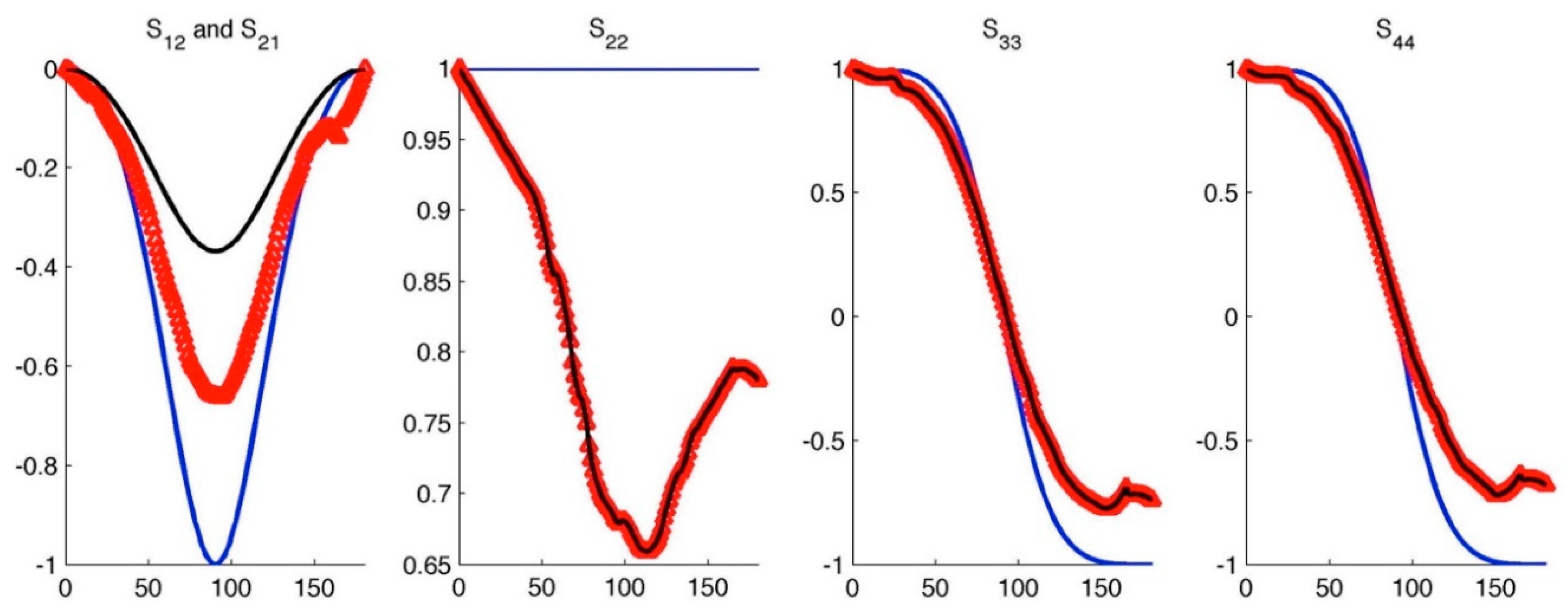

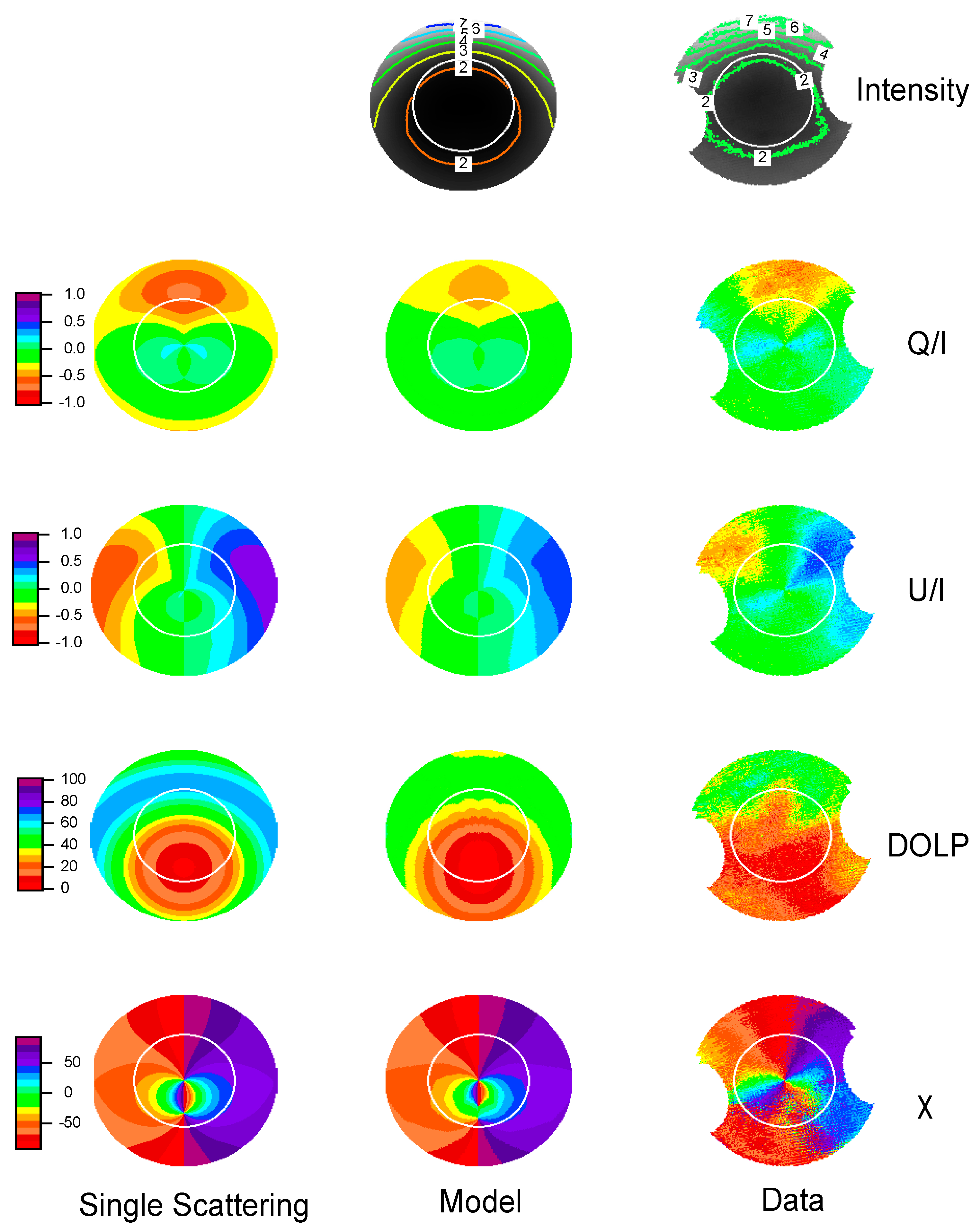
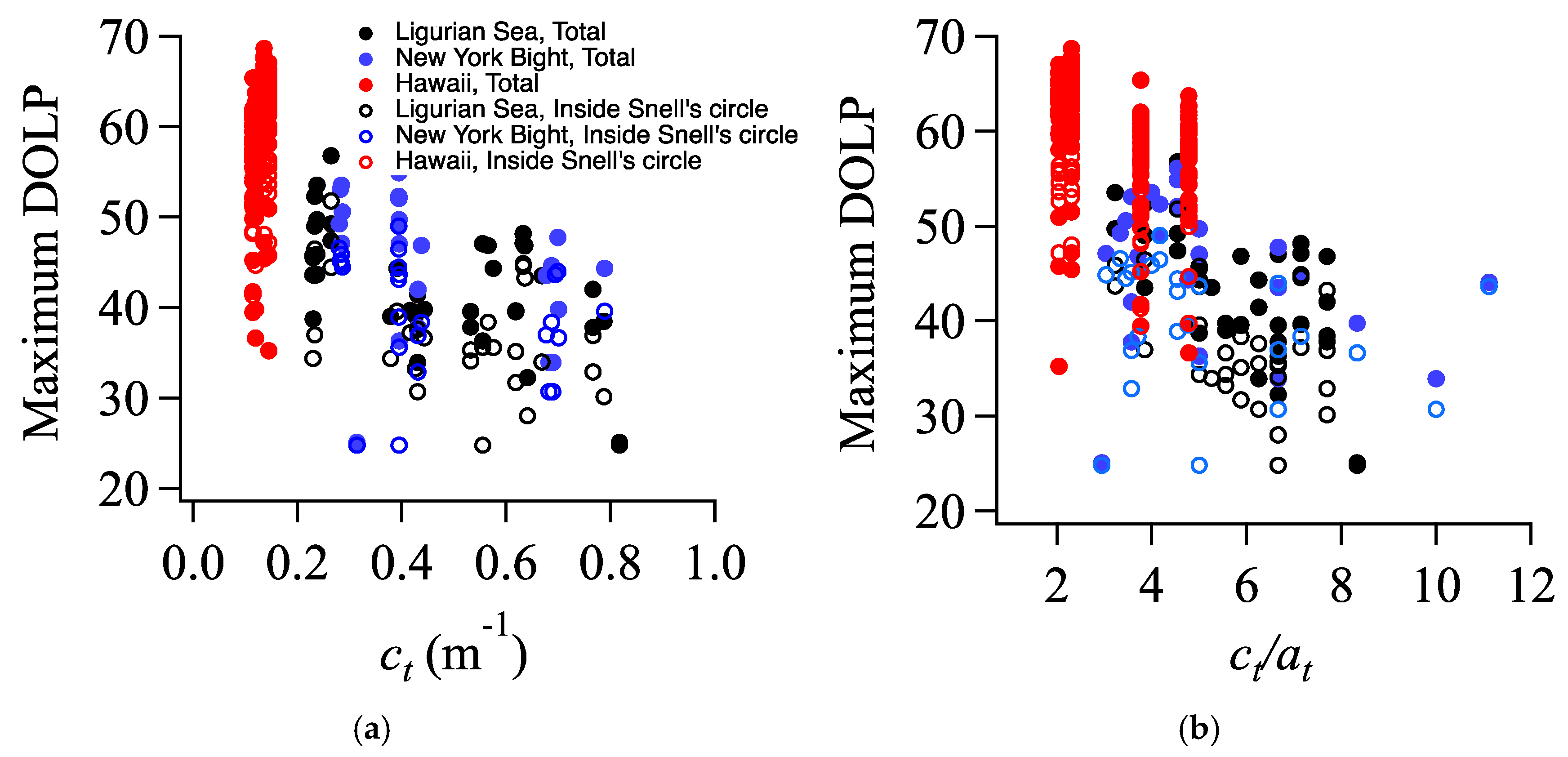
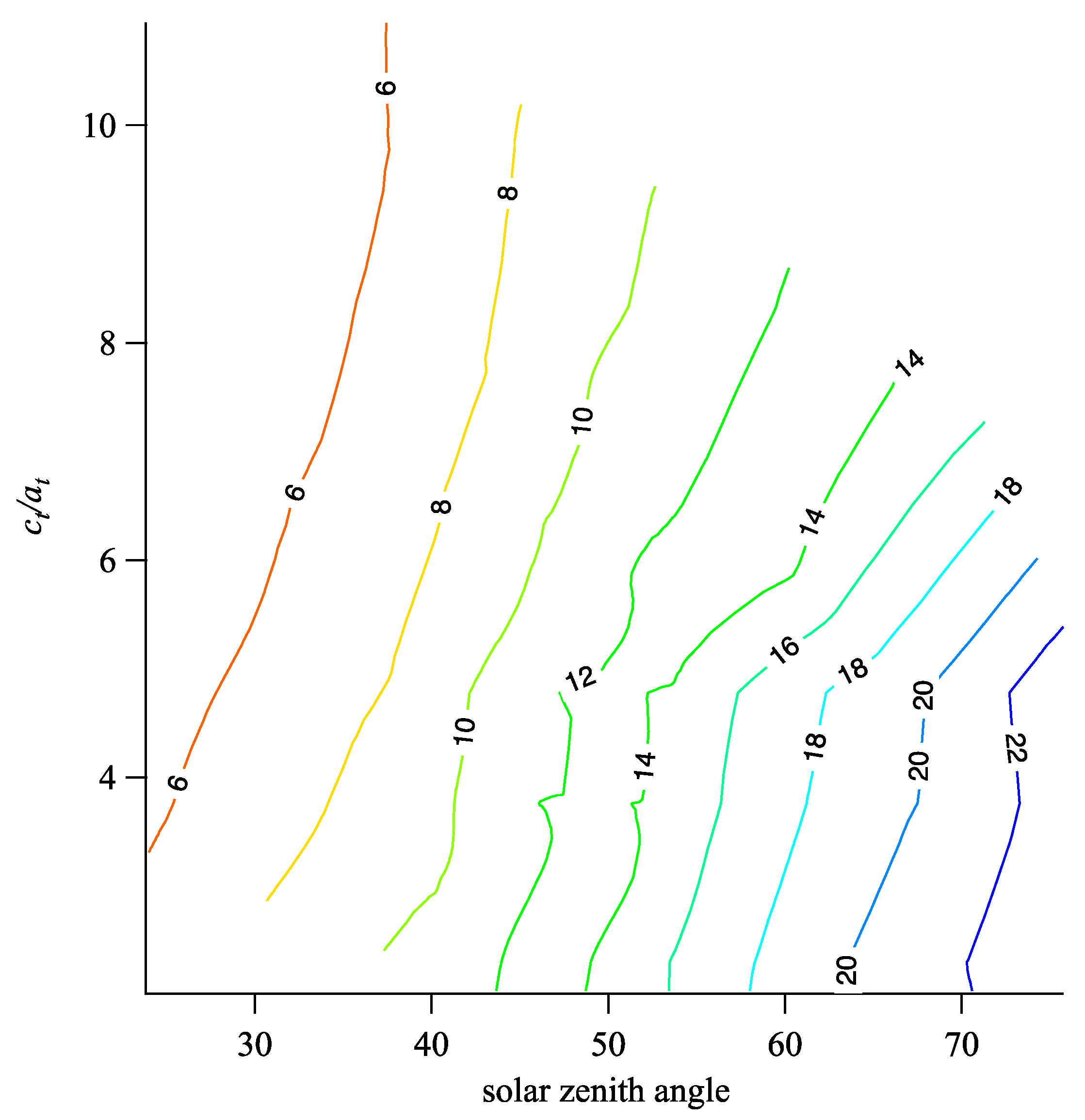
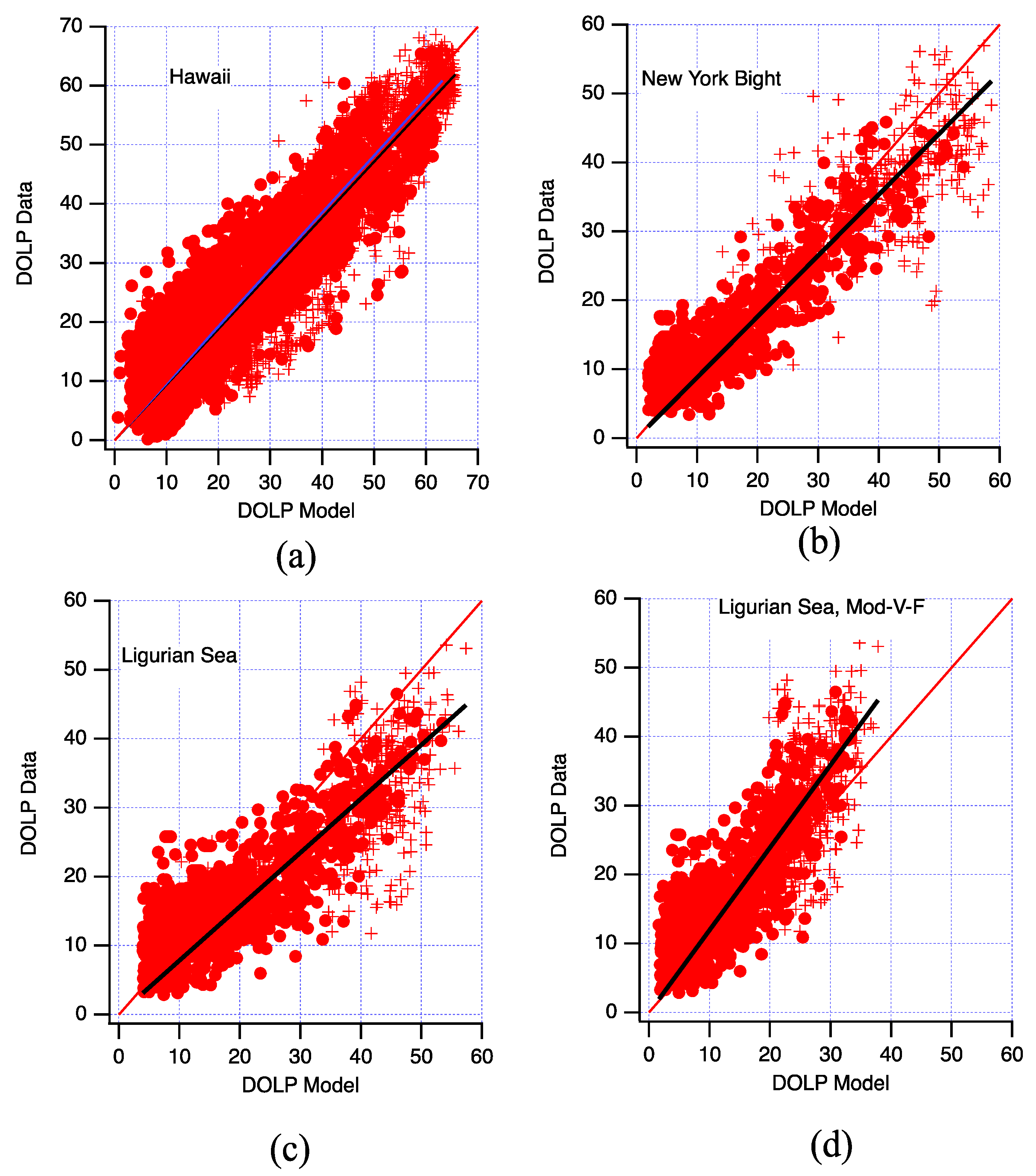
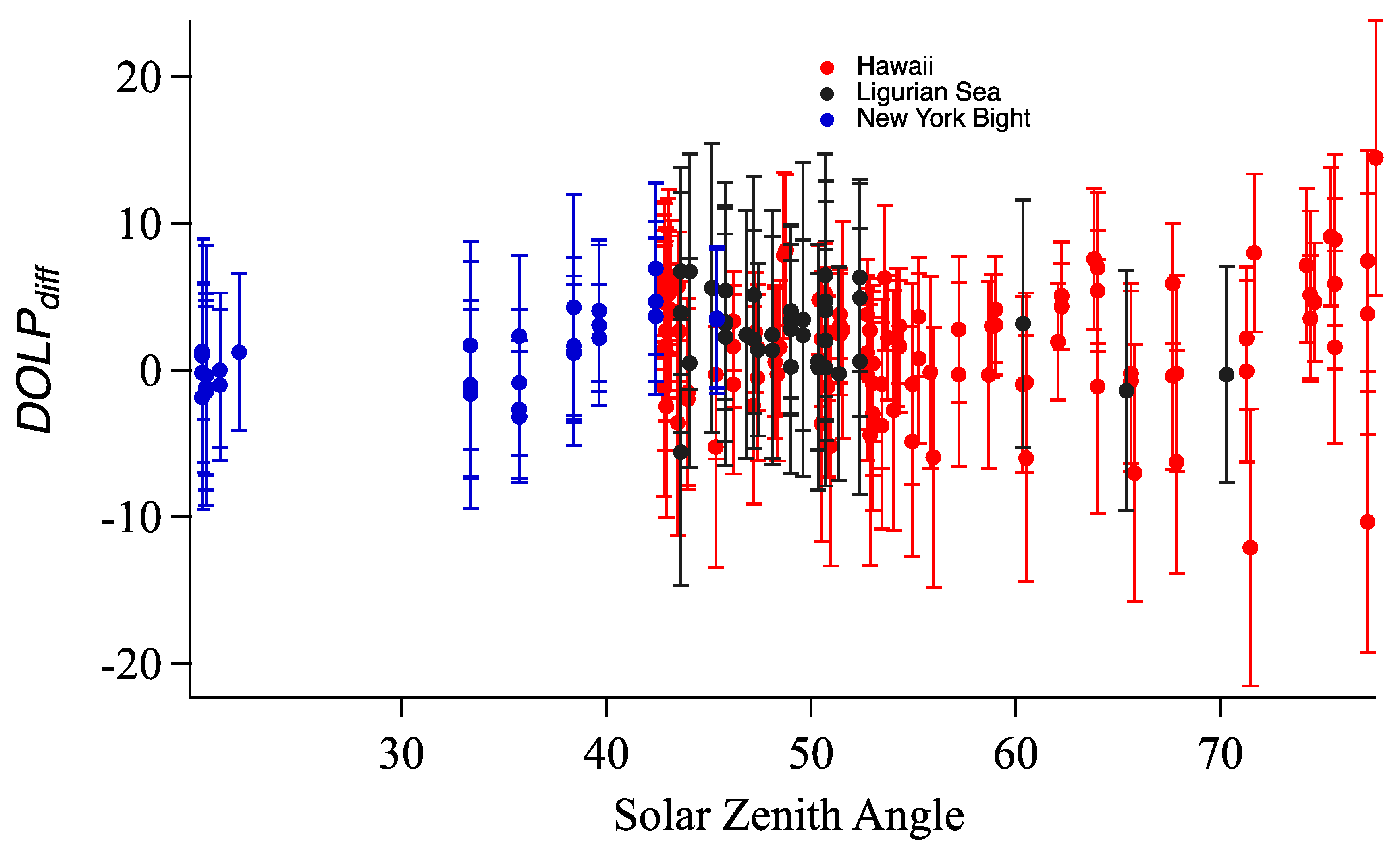
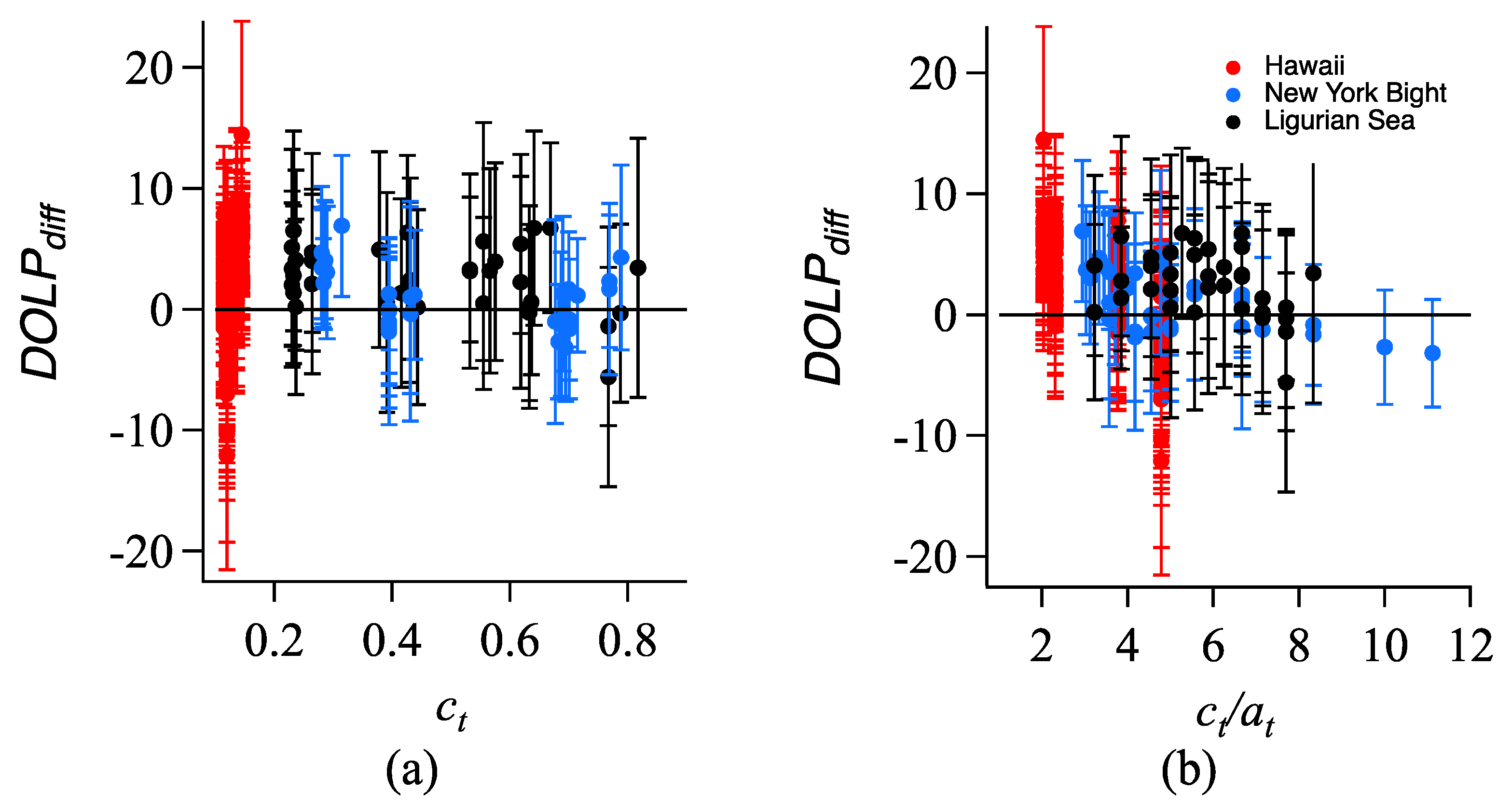

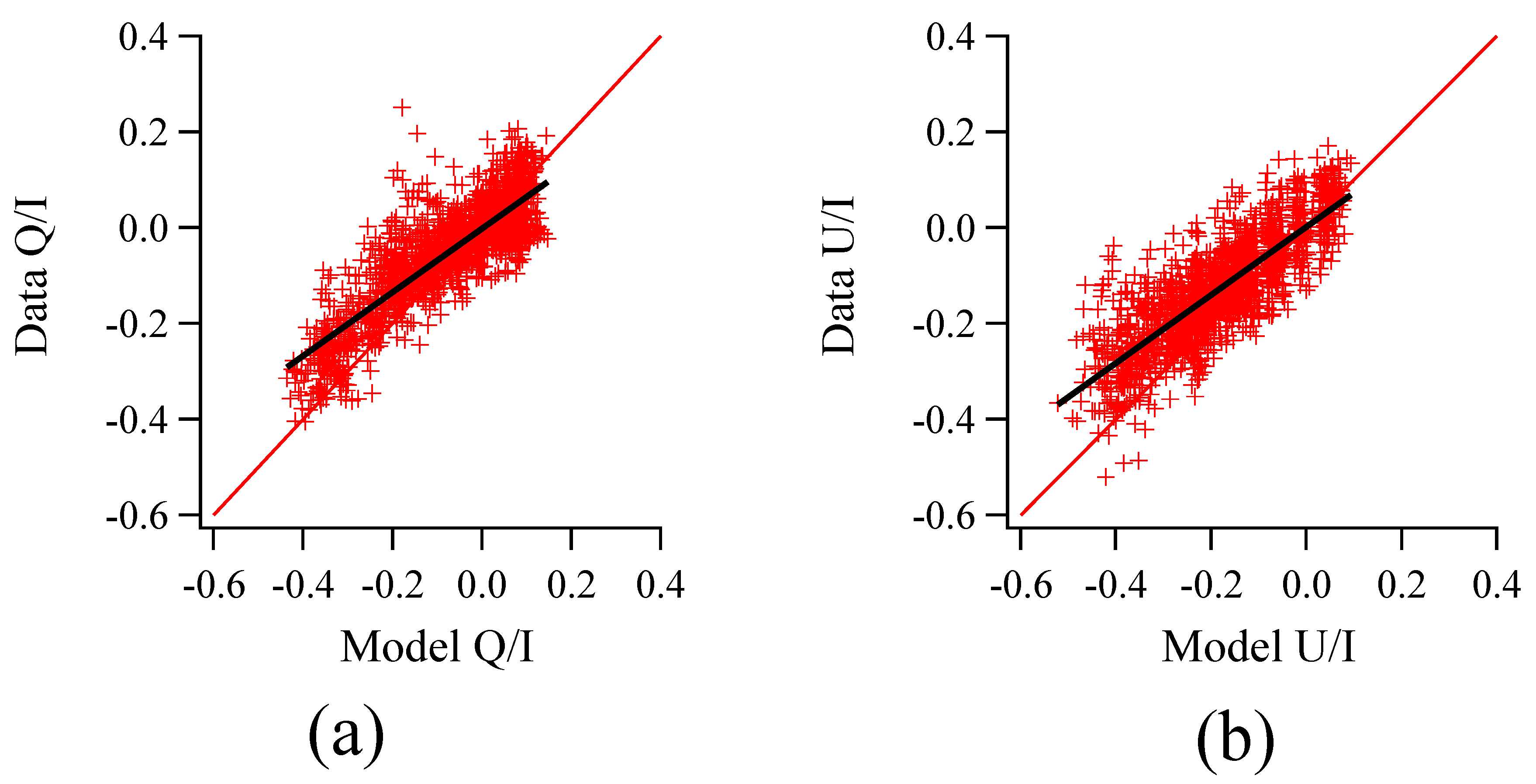
| Experiment | N ( nm) | N ( nm) | N ( nm) | N ( nm) |
|---|---|---|---|---|
| Hawaii | 27 (436 nm) | 31 (486 nm) | 28 (526 nm) | 24 (548 nm) |
| Ligurian Sea | 9 (442 nm) | 9 (488 nm) | 13 (520 nm) | 14 (550 nm) |
| New York Bight | 7 (442 nm) | 8 (488 nm) | 9 (520 nm) | 7 (550 nm) |
© 2018 by the authors. Licensee MDPI, Basel, Switzerland. This article is an open access article distributed under the terms and conditions of the Creative Commons Attribution (CC BY) license (http://creativecommons.org/licenses/by/4.0/).
Share and Cite
Gleason, A.C.R.; Voss, K.J.; Gordon, H.R.; Twardowski, M.S.; Berthon, J.-F. Measuring and Modeling the Polarized Upwelling Radiance Distribution in Clear and Coastal Waters. Appl. Sci. 2018, 8, 2683. https://doi.org/10.3390/app8122683
Gleason ACR, Voss KJ, Gordon HR, Twardowski MS, Berthon J-F. Measuring and Modeling the Polarized Upwelling Radiance Distribution in Clear and Coastal Waters. Applied Sciences. 2018; 8(12):2683. https://doi.org/10.3390/app8122683
Chicago/Turabian StyleGleason, Arthur C. R., Kenneth J. Voss, Howard R. Gordon, Michael S. Twardowski, and Jean-François Berthon. 2018. "Measuring and Modeling the Polarized Upwelling Radiance Distribution in Clear and Coastal Waters" Applied Sciences 8, no. 12: 2683. https://doi.org/10.3390/app8122683
APA StyleGleason, A. C. R., Voss, K. J., Gordon, H. R., Twardowski, M. S., & Berthon, J.-F. (2018). Measuring and Modeling the Polarized Upwelling Radiance Distribution in Clear and Coastal Waters. Applied Sciences, 8(12), 2683. https://doi.org/10.3390/app8122683





